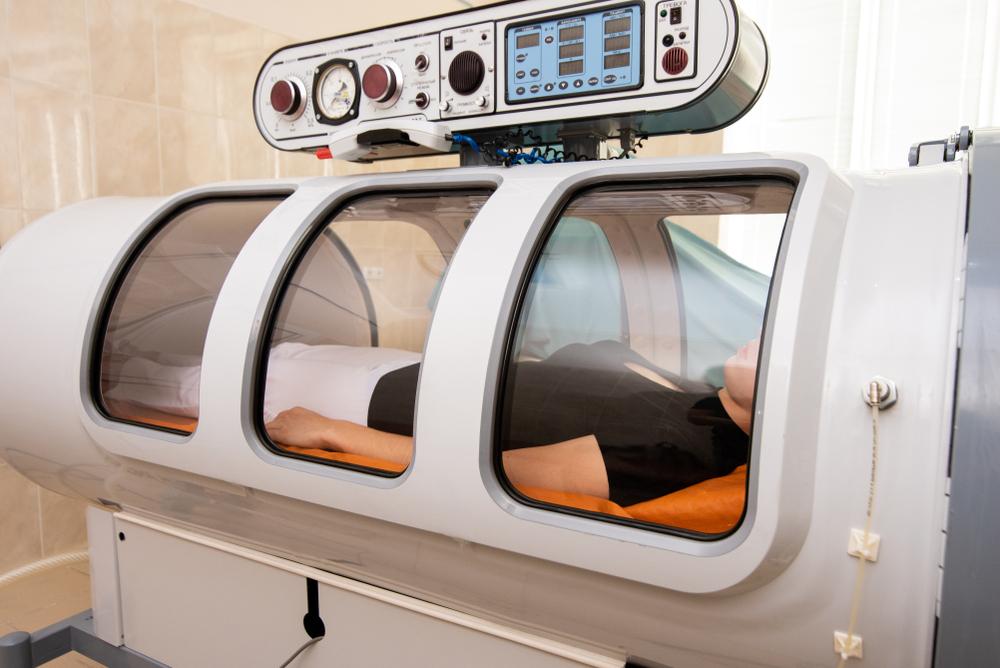
Hyperbaric Oxygen Chambers Proven to Help with Bone Infections, Burns, Gangrene, Wound Healing, Anemia and More
Hyperbaric (from the Greek "hyper" or high and "baros" or weight) describes a condition in which gas pressure is greater than the atmosphere's pressure at sea level. You'll most likely see this term in relation to a popular treatment called hyperbaric oxygen therapy (HBOT).
With HBOT, a person sits inside a special room or chamber that's gradually pumped full of 100% pure oxygen until it reaches an air pressure of up to three times more than what's found outside. The person breathes in this oxygen-rich air for a couple minutes to a couple hours, depending on the treatment.
The ultimate goal is to fill the body with oxygen and accelerate the body's healing process—a phenomenon well-documented by science.
How Does Hyperbaric Oxygen Therapy (HBOT) Work?
HBOT dates to the early 20th century. It was first used to treat someone ill with the flu. Later, it became an effective treatment for people experiencing carbon monoxide poisoning or decompression sickness ("the bends"). As the popularity of hyperbaric oxygen therapy grew, people began using it to treat a variety of acute and chronic health conditions.
According to Johns Hopkins Medicine, HBOT works in several key ways:
- Since the lungs absorb up to three times as much oxygen as they normally would, HBOT helps a person's blood, tissues, and organs to become flooded with oxygen. This reduces swelling associated with injuries, and can prevent cellular death caused by damaged blood vessels and edema-induced oxygen starvation.
- HBOT boosts the body's immune system by helping tissues resist infection, improving white blood cell function, and rendering certain types of bacteria ineffective.
- "Reperfusion injury" is severe tissue damage that happens when tissues are suddenly resupplied with blood after they've been temporarily deprived, such as after a crush injury. It causes cells and tissues to release harmful compounds called oxygen radicals, which creates further damage. HBOT can prevent reperfusion injury by supporting special molecules in the body that seek out and counteract these harmful radicals.
- Lastly, HBOT promotes the growth of new blood vessels, new skin cells, and collagen—the "glue" holding connective tissues together and the most abundant protein in the body (collagen levels naturally decrease with age).
Health Benefits of Hyperbaric Oxygen Chambers
So, should you schedule a session to kick back in a hyperbaric oxygen chamber near you? Here's what some research says about this innovative therapy, which may help you decide if it's worth your time:
- Back in 1998, a paper was published in the British Medical Journal highlighting the main therapeutic uses of HBOT. The authors of the paper cite "strong" evidence supporting the use of HBOT for decompression sickness ("the bends"), smoke inhalation, carbon monoxide poisoning, and skin graft healing. This paper and research also found that HBOT can help people with bone infections (osteomyelitis), burns, radiation injury, gangrene, acute traumatic ischemic injury (including crush injuries and compartment syndrome), delayed wound healing, and blood loss anemia.
- A more recent 2015 paper from Health Science Journal shared that HBOT can reduce the risk of amputation in people with non-healing diabetic foot ulcers, plus significantly increase the survival rates of a gangrenous muscle infection called clostridial myonecrosis.
- Additionally, a 2005 paper published in Sports Medicine discussed the rising popularity of HBOT among elite athletes. At the Nagano Winter Olympics, for example, HBOT was offered to athletes as an effective way to combat performance fatigue. Many athletes are also interested in HBOT because it appears to reduce swelling after acute sport injuries and supports the remodeling process during healing. This potentially means a faster recovery from injuries involving connective tissues such as muscles, ligaments, tendons, and bones.
Keep in mind that hyperbaric oxygen therapy has not yet been proven to treat many of the conditions that some manufacturers claim it can, including autism, cancer, diabetes, dementia and multiple sclerosis. This doesn't necessarily mean that HBOT can't yield beneficial results for people with these conditions. But until and unless there's enough data to support these claims, the Food and Drug Administration (FDA) likely won't approve HBOT for these indications.
Like any medical treatment, there are also some risks associated with HBOT. These include joint pain, sinus pain, eye problems, middle ear damage, and in less common but severe cases paralysis, pulmonary embolism, or seizures caused by oxygen poisoning. HBOT may be contraindicated in some people, including people who are claustrophobic, people who have had recent ear surgery, and people with certain lung diseases.
Oxygen-rich environments are an increased risk for fire, so it's imperative to use HBOT in facilities that have FDA-approved medical grade equipment, trained medical staff, and strict adherence to FDA protocols and safety procedures.
Talk to your doctor if you're interested in trying HBOT for yourself. You and your provider can decide if the therapy is right for you, and if so where you can go to undergo reputable treatment.
https://www.mayoclinic.org/tests-procedures/hyperbaric-oxygen-therapy/about/pac-20394380
https://www.ncbi.nlm.nih.gov/pubmed/16138784
https://www.medicinenet.com/script/main/art.asp?articlekey=14221
https://www.hopkinsmedicine.org/health/treatment-tests-and-therapies/hyperbaric-oxygen-therapy
https://www.medicalnewstoday.com/articles/313155.php
http://www.hsj.gr/medicine/the-inspiring-journey-of-hyperbaric-oxygen-therapy-from-the-controversy-to-the-acceptance-by-the-scientific-community.php?aid=6885
https://www.ncbi.nlm.nih.gov/pmc/articles/PMC1114115/





.png?v=14052428765372906161761701960) Previous Post
Previous Post
%20copy.png?v=62173825240595680121761701960)